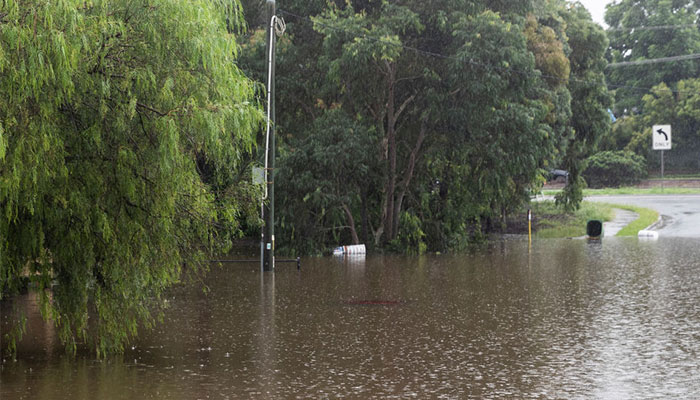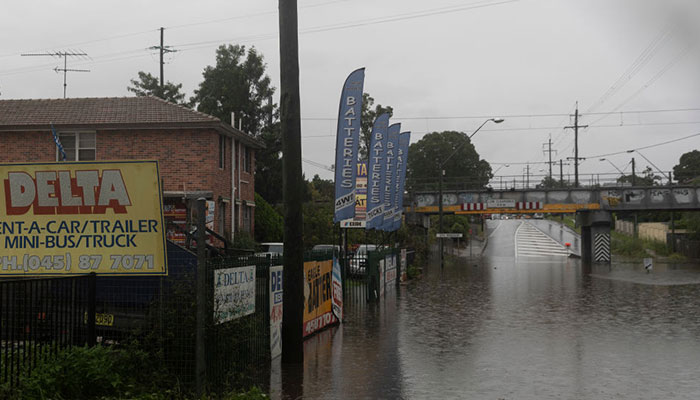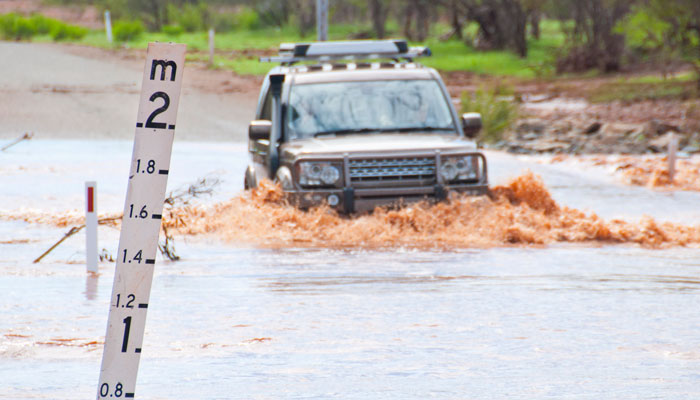Of the 822 flood rescues that have taken place in NSW since rain began lashing the state on March 10, around half the operations were launched to rescue drivers trapped in cars, a State Emergency Service (SES) spokesperson told the Lighthouse today.
Both the police and SES have again issued warnings to stay off the road particularly on the mid-north coast of the state and in the Hawkesbury-Nepean regions. But Macquarie research has shown drivers continue to take risks in flood-ravaged regions.

Deadly risk: A car (centre) is seen submerged during heavy flooding in Windsor, NSW, on March 22. Photo: Brook Mitchell /Getty Images
While roads and schools have been closed and workers told to stay home, the Premier Gladys Berejiklian announced that more than 18,000 people have been evacutated so far from across the state during the flood emergency, which has hit hard in Western Sydney and on the Mid-North Coast.
Research by the Bushfire and Natural Hazards Cooperative Research Centre found that most of the 178 flood-related deaths in Australia since 2000 have resulted from motorists driving into flood waters.
Driving through floodwater is an entrenched social behaviour - many people make a deliberate choice to do it.
Even though floodwaters are the nation's second-highest natural disaster killer – after bush fires – Macquarie research found drivers continue to take risks, with findings suggesting that many people think they know how to work out when it's safe.
Macquarie research fellow Andrew Gissing says that driving through floodwater is an entrenched social behaviour - and many people make a deliberate choice to do it.

(Life-threatening: Heavy flooding in Windsor on March 22, 2021. Photo: Brook Mitchell/Getty Images
"The safety of floodwater can often be very difficult to judge - in particular the speed and depth of the water and what might be underneath," Gissing says. "Making only a slight error of judgement can be the difference between life and death.
"Flooding in Australia is deadlier and more damaging than bush fires - fatalities are commonly the result of people driving or walking through flood water. People understimate the power of a current and only a small mistake can lead to people drowning.
Our research shows that young males in particular are most likely to drive through floodwater and the most prevalent vehicle is a 4WD.
Gissing's team conducted research following West Australian floods in 2017, funded by the Department of Fire and Emergency Services. Using focus groups and surveys of residents, they examined what determines people's decision-making around entering flood waters. About 84 per cent of those interviewed had experienced flooding on the road while driving.
The research found that while nearly everyone agreed that entering floodwater is dangerous – most people also believed they could assess some circumstances where it's safe.
Repeat offenders
"For example, 26 per cent believed that it was somewhat or completely safe to drive through knee-deep still flood waters.
"The majority of drivers who had entered flood waters had done so on multiple occasions and would do so again if faced with the same circumstances."

Deadly risk: Flood waters are the nation's second-highest natural disaster killer after bush fires.
Many of these drivers also didn't have good knowledge of the limitations of their vehicles in floods, he adds.
"When uncertain, some drivers claimed to take further actions to reduce the uncertainty, such as walking into the flood water to assess water depths and velocity before deciding to enter, or watching another vehicle drive across."
There were three key things that drivers thought they could judge: the level of danger involved in the flood water, the safety of their vehicle, and their own skill as a driver.
"It can be very hard to judge the depth and the speed of flood waters, which can rise up very quickly," he said.
Research shows that cars can sink in deep water in just a few minutes, and many deaths from floods involve passengers trapped in submerged vehicles.
Natural hazards research shows that cars can be swept quickly from a roadway into deep water nearby, and safety measures that governments can implement include installing roadside barriers, depth indicators, good lighting and prioritising road closures in known danger zones.
"Despite prominent warning signs and road closures, though, people persist in driving into floods," Gissing said.
Could you judge dangerous floodwaters?
Education campaigns and warnings from emergency services generally agree on the message to never enter flood waters. But this message may be ineffective for many drivers – because even though they acknowledge the dangers, many who hear the message have escaped harm when they've previously driven into flood waters.
"Also, given the differing definitions as to what flood waters are, the message is open to individual interpretation," Gissing said.
He suggests that better messaging could question whether people can accurately interpret flood conditions and whether it's safe to cross floodwaters, despite previous experience.
"We need to highlight how much uncertainty there is when you assess flood waters and how experience from previous floods won't translate each time because they are all different.
"Misjudging flood water depths by just centimetres can be deadly."
Andrew Gissing is an emergency risk management and resilience expert and Adjunct Fellow in the Department of Environmental Sciences. An earlier version of this story was published on November 28, 2018.






